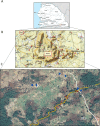A 12-year follow-up of intestinal schistosomiasis in pre-school-aged children in Assoni Village, Eastern Senegal
- PMID: 34176498
- PMCID: PMC8237420
- DOI: 10.1186/s40249-021-00867-8
A 12-year follow-up of intestinal schistosomiasis in pre-school-aged children in Assoni Village, Eastern Senegal
Abstract
Background: To monitor the prevalence of schistosomiasis in school-aged children (SAC), the National Bilharzia Control Program (PNLB) was set up by the Senegalese authorities; however, geographically isolated Bedik ethnic groups that did not benefit from this program were found to be heavily infected with Schistosoma mansoni. This observation led us to implement a new schistosomiasis control program in 2008 under the aegis of the non-governmental organization "Le Kaïcedrat" and in partnership with the PNLB/WHO to monitor the prevalence of schistosomiasis in this area. In the village of Assoni, where 100% of SAC were infected, analysis of the stools of pre-school-aged children (PSAC) showed that they were massively infected, so we decided to focus our program on them.
Methods: From 2008 to 2020, we (i) monitored the prevalence of S. mansoni in PSAC in Assoni using double-stool smear preparation, (ii) treated the infected PSAC with a standard dose of praziquantel 40 mg/kg, (iii) ran educational campaigns each year in the village, and (iv) built latrines to improve sanitation and reduce schistosomiasis transmission. Linear regression was used to examine the trend in the annual schistosomiasis prevalence and a two-sided of Chi-squared test was used to compare prevalence between the different age groups of PSAC.
Results: We observed an extremely high prevalence of schistosomiasis (78%) in PSAC before implementation of the program in 2008. Contamination occurred in very young children, as 64.3% of children under 2 years old were infected. Moreover, prevalence increased with age and reached 96.8% in children 4 to < 6 years old. Our annual interventions in Assoni Village raised awareness among villagers that water bodies were areas of significant infestation, allowed the building of 88 latrines and led to a decrease in prevalence in PSAC as only 11% of these children were infected in 2020.
Conclusion: Our study allowed Assoni to be the first village in Senegal to treat PSAC since 2014, but only on an individual basis. It also shows that schistosomiasis is difficult to eradicate and that multi-sectorial actions are required to keep its prevalence at a low level.
Keywords: Intestinal schistosomiasis; Latrine; Praziquantel; Pre-school-aged children; Prevalence; Senegal.
Conflict of interest statement
Authors declare no conflicts of interest.
Figures




References
-
- World Health Organization. Schistosomiasis (Bilharzia) Fact Sheets Available online: https://www.who.int/health-topics/schistosomiasis#tab=tab_1. Accessed 27 Apr 2021.
-
- GBD 2016 DALYs and HALE Collaborators. Global, regional, and national disability-adjusted life-years (DALYs) for 333 diseases and injuries and healthy life expectancy (HALE) for 195 countries and territories, 1990–2016: a systematic analysis for the Global Burden of Disease Study 2016. Lancet. 2017;390,1260–1344. - PMC - PubMed
-
- World Health Organization. Ending the Neglect to Attain the Sustainable Development Goals: A Road Map for Neglected Tropical Diseases 2021–2030. 2020.
MeSH terms
Substances
Grants and funding
LinkOut - more resources
Full Text Sources
Miscellaneous

